Introduction
Among many exotic and extinct fauna, thirteen species of Darwin’s finches, namely Geospiza fortis, G. scandens, G. magnirostris and G. fuliginosa harbor Galápagos Islands, Santa Cruz, and Daphne Major (Grant & Grant, 2008). According to Grant and Grant (1995), these species have displayed remarkable evolutionary adaptations to survive harsh conditions, especially severe droughts during 1976-77 and 1984-1986. Various morphological traits used for evaluating the natural selection in finches were: body weight, beak dimensions, wing and leg size, seed preferences etc. (Price et al., 1984; Grant et al., 1976; Grant, 1991), including some inheritable traits like beak size (Grant & Grant, 2008). Interestingly, selected traits varied in the above two draught seasons, for e.g. in 1976 large beaks were preferred but small beaks adapted to 1984 drought.
The present investigation is envisaged to ascertain the precise factor(s) that might have caused deaths in finches during 1973-1978, and led some Finches to survive. The analysis is based on two questions and four hypotheses each:
- Why did finches die – the hypotheses were
- The finches died because the lack of seeds.
- The finches died because the lack of rainfall.
- The finches did not die (null hypothesis)
- The finches died because of predators.
- Why did some finches survive – the hypotheses were
- The finches survived by feeding on alternate seeds.
- The finches survived the lack of rainfall.
- The finches did not survive (null hypothesis)
- The finches escaped the predators to survive.
Methods
The data on different traits were obtained for wet and dry months of 1973-1978 from a program titled “The Galápagos Finches” (Jackson & Hughes, 2009) with source data derived from the original papers. The data on different groups and populations of fringes (survived, died; adults, fledglings; male, female) and different traits (weight, beak length, wing length and leg length) were pooled and compared in dry and wet seasons of the years. Systematic compilation of the surviving populations and dead populations was done with attributes like less or more weights, shorter or longer beaks, wings, and legs. Using DOUBLE Y PLOT graphs each of died and survived Populations were scaled towards the right Y-axis, and the remaining information was plotted on Y and X axes. Therefore, for each trait, two graphs were plotted one each for dead and survived populations, and all eight graphs covered the four traits.
Results & Discussion 1 – Why die question
The finches died because the lack of seeds
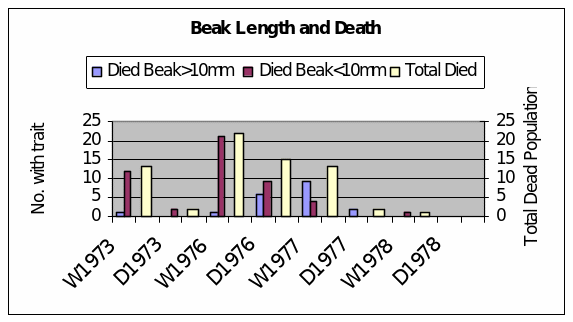
The data correlating beak length and mortality is shown in above figure. Among the dead populations, fringes with beak length <10 mm died more often and in greater number than those having >10 mm beak length. The only exception was dry 1976, when the trend was opposite. This data is explanatory that smaller beak size (<10 mm) is an unselective trait in the fringes and these fringes exhibited higher mortality than those with larger beaks. Therefore, the given hypothesis is accepted.
The finches died because the lack of rainfall
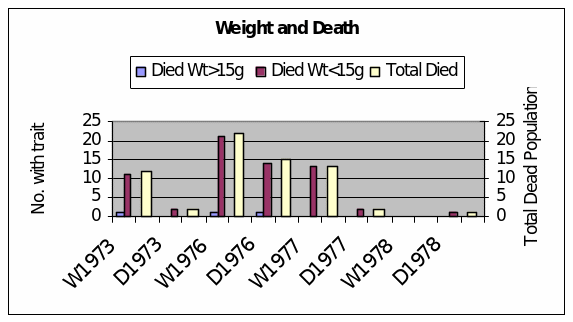
In the above figure it can be seen that overall dead population is higher during dry seasons compared to wet seasons, which initially suggests that lack of rainfall results in higher mortality. However, the difference in 1976 was not so pronounced (22 against 15) and this has led to believe that mortality can not necessarily be correlated with drought. There was an increase in total population of finches in wet seasons due to fledgling younger birds which grew up in dry seasons.
It was further noted that most of the smaller birds (<15 g) which included the fledgling birds exhibited significantly higher mortality than those which were larger. This indicates that the lighter birds were fragile and week to cope with the harsh drought seasons as against the wet season.
The finches did not die (null hypothesis)
This is indeed not correct and this hypothesis is rejected on account of higher overall mortality of total population until 1977. This can be clearly seen in the above figures (total dead populations).
The finches died because of predators
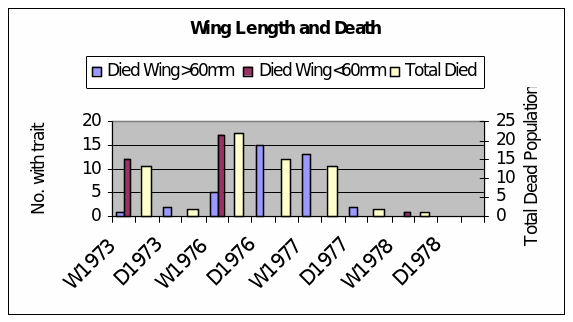
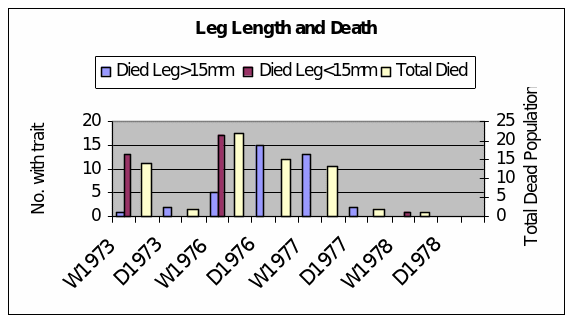
Both Wing length and leg length are the attributes directly related to flying and running ability in order to escape or hide from predators. These features also determine body size and energetic status of the birds. In above figures the trend for varying sizes of wings and legs correlated with each other. Apparently, initial (year 1973) higher mortality was seen in birds with smaller wings and legs but from 1976 onwards mortality for larger wings and leg size increased. As wing and leg lengths did not determine selective deaths in populations, we reject the hypothesis that predation was the main cause of death.
Results & Discussion 2 – Why Survive question
The finches survived by feeding on alternate seeds
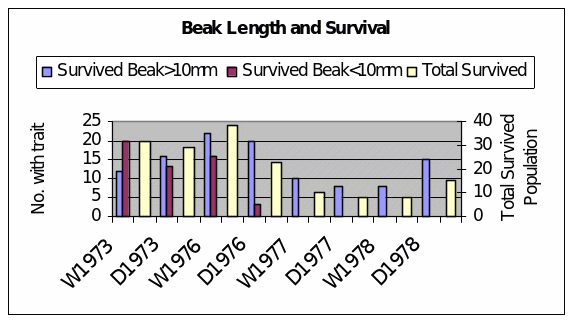
In above figure, it can easily be made out that while in year 1973 (dry and wet) birds with both smaller beaks (<10 mm) and larger beaks (>10 mm) had advantage, from dry 1976 , only the birds with lager beak size survived. From the data obtained from wet 1978 survived fledgling birds, it is further noticed that the young birds with large beak size similar to size of adults (>10 mm) survived more than those with regular small beak size. As during this period the fringes with smaller beaks displayed higher mortality it is unambiguous that large beak is a selected trait for survival. Such birds could break open large and hard seeds when smaller seeds perished due to drought, and did not starve. The given hypothesis is therefore accepted.
The finches survived the lack of rainfall
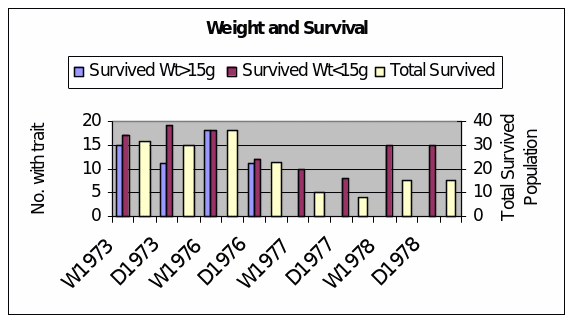
From the above figure it is clear that regardless of wet or dry months there was not much difference in number of total survived population, with a trend of decreasing in number in later years. This data of seasonal surviving birds and inconsistent mortality data of total dead populations indicate that it may be premature to correlate lack of rainfall with survival or mortality of the birds. Hence, this hypothesis is presently rejected.
There is an interesting feature of survival of less weighed birds (< 15 g). During wet 1973- wet 1976, birds of both weights (</> 15 g) survived equally, but from dry 1976 onwards only the lighter birds preferentially survived. As the light birds also had higher mortality than heavier ones, it was not possible to correlate weight of the birds with survival.
The finches did not survive (null hypothesis)
This is of course not happening because from wet 1977 season onward the total surviving population increased and stabilized. At this time of study the mortality was low, indicating that the birds were adapted to survive and multiply in population size, and thus we reject this null hypothesis.
The finches escaped the predators to survive
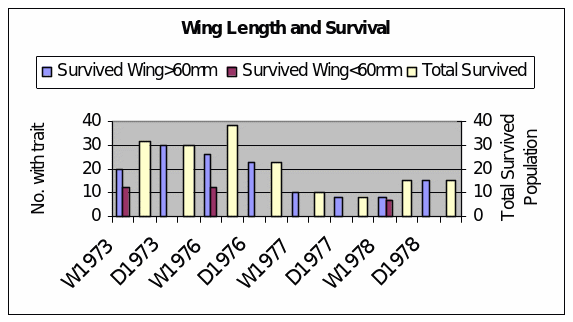

The trend of survived population and relative survival of small and large sized wings (</> 60 mm) or legs (</> 15 mm) was quite similar. Although the surviving birds from dry 1976 onwards did exhibit greater leg and wing lengths, with exception of Wet 1978, the mortality of these larger winged and legged birds was also quite high in the corresponding periods. These attribute rule out any possibility of selection of better flying and evading ability in the birds to escape or hide from the predators. Another observation that less weight fringes survived wet 1977 onwards rules out any role of predation as these fringes would have been easier pray than more weighed birds. Hence the hypothesis that anti-predation is a surviving attribute, is rejected.
Overall Conclusion
The data clearly reveals that only convincing trait that can be correlated with survival of the finches is beak length. Birds with larger beak length (>10 mm) had an advantage in evolution. In drought seasons woody fruits of Tribulus were the common feed, and only the birds with strong and long bill had an ability to crack the fruits. Previous work also pointed out about this feature as selectable trait and it was also found to be inheritable (Grant & Grant, 2008). Moreover, it is likely that wet vs. dry seasons’ variations in the mortality could be due to feeding neglect as less seeds were available in drought. Apparently, there is no direct effect of the wet or dry season on bird’s survival. Survival of less weighed adult and fledgling birds was unusual observation, which contradicts earlier theory that bigger size and heavier birds have evolutionary advantage owing to better mating and foraging abilities (Price et al., 1984; Grant et al., 1976). Wing and leg size associated with prevention from predation seems to have no correlation with fringe survival.
References
Grant, B.R. & Grant, P.R. 2008. Fission and fusion of Darwin’s finches populations. Philosophical Transactions of the Royal Society B, 363, 2821–2829.
Grant, P.R. 1991. Natural selection and Darwin’s finches. Scientific American, Issue, 82-87.
Grant, P.R. & Grant, B.R. 1995. Predicting microevolutionary responses to directional selection on heritable variation. Evolution, 49(2), 241-251.
Grant, P.R., Grant, B.R., Smith J.N.M., Abbott, I.J. & Abbott, L.K. 1976. Darwin’s finches: Population variation and natural selection. Proceedings of the National Academy of Sciences USA, 73(1), 257-261.
Jackson, J. & Hughes, M. (2009). The Galápagos Finches. Web.
Price, T.D., Grant, P.R., Gibbs, H.L. & Boag, P.T. 1984. Recurrent patterns of natural selection in a population of Darwin’s finches. Nature, 309, 787-789.